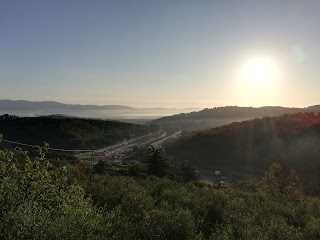East of Pescia, the Cammino di San Jacopo in Toscana takes to the hills, forsaking the busy roads of the industrially developed valley below and passing through hilltop villages dating back to the middle ages, when the valley was a mosquito-infested swamp. Like all Italian towns and villages, these centres are connected by a network of mulattiere, pathways paved in stone travelled by peasant farmers with their pack mules before the days of the automobile. Many of these have been reclaimed as part of the Cammino di San Jacopo in Toscana and other trail networks.
 |
| Follow the orange arrow for Florence and then Rome... Or the yellow arrow for Lucca and, eventually, Santiago! |
 |
| Mulattiera leading into the village of Uzzano |
 |
| Uzzano |
 |
| Uzzano: loggia containing water fountain |
 |
| View of Pescia from Uzzano |
 |
| Uzzano: Church of San Jacopo & San Martino |
After exploring Uzzano I continued along the path through the olive groves and woods to Stignano and then Buggiano Castello. On the way I passed under an old aqueduct and over a medieval stone bridge.
 |
| Stignano: church of Sant'Andrea |
 |
| Stignano: book exchange |
 |
| Buggiano Castello in the distance : Do I really have to go all the way up there? |
 |
| Buggiano Castello |
Coming down from Buggiano I made an unintentional detour by going the wrong way to get around an obstacle, a closed path through a park. I had to backtrack and then walk along a busy road through the oddly named town of Margine Coperta, but when I joined up with the official route again, I realised why the park was closed: it belongs to the national health service, which has now set up a drive-through Covid testing facility in the park!
Right after this I came into Montecatini Terme, where I stopped to eat my picnic lunch in a city park before visiting the town. It looked a bit like a ghost town, its legendary splendours fading, its fancy hotels shut and its renowned spas in art deco style faded and crumbling; even the streets and sidewalks gave the impression of falling apart! Sure, it's early afternoon, on a week day, at the end of the summer... In the year of the plague. But this town looked as though it had been decaying for many decades, now that the likes of Giuseppe Verdi and Federico Fellini no longer hang out there. Once Italy's most fashionable spa town, it is now abandoned and neglected; the "jet set" has moved on, or maybe no longer exists. As a result there were plenty of cheap hotel rooms to be had in the town, but I found it rather gloomy and preferred to move on.










Before leaving Montecatini, however, I did treat myself to a ride on the world's oldest operational cable car, inaugurated in 1898 in a ceremony attended by Giuseppe Verdi! The bright red car rumbled and ground its way up, taking me and Gregory (my new pack) up to the old town, Montecatini Alto, and back down again - and no, I didn't count those kilometres in my daily total!
 |
| Gregory's first cable car ride |
 |
| View of Montecatini Terme from Montecatini Alto |
 |
| Strange things to be found in Montecatini Alto |
 |
| The main square in Montecatini Alto, full of restaurants and much livelier than the new town below! |
After this adventure, the rest of the afternoon was unexciting - out of the town of Montecatini through suburbs, past more empty hotels, then along the pavement to Pieve di Nievole. From here the trail was supposed to go along the river bank, but it was overgrown with a thicket of bamboo cane and a sign recommended an alternative route along the road. For the rest of the way, the trail followed small gravel and paved roads parallel to the motorway - a familiar stretch of motorway to me, travelling frequently between Tuscany and Liguria. And I stopped for the night very close to the motorway rest stop where we often stop on our way - without a thought to what lies beyond the guard rail - at a historic building that demonstrates that this location has been a crossroads for a very long time: La Magione, former House the Knights Templar, where they hosted pilgrims at the junction of the Via Cassia and the Via Francigena, now a hotel, restaurant and pizzeria.
 |
| Walking beside the motorway |
 |
| Crossing the motorway |
Pescia - La Magione 22.5 km





































































